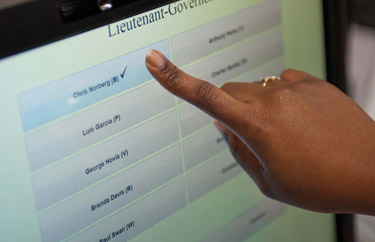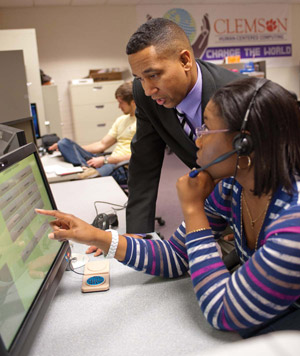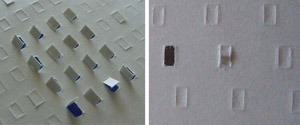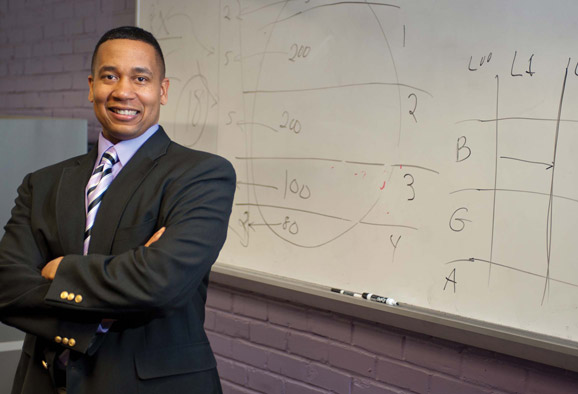The objective? — Change the world.
Tom Hallman
Why not begin with a voting booth anyone can use?
Forget microchips. At the heart of every computer lies a purpose, a human purpose. Some deed that must be done, some task accomplished. Without that human need, no computer would ever feel the pulse of electrons through its processor. No microchip would have a job.
This is the foundation on which Juan Gilbert builds the next generation of computer applications to help people do what they need to do but do it better.
In a cinderblock lab on the ground floor of the School of Computing, teams of students and faculty create new ways to allow people to text one another without typing. They develop software that will alert patients to adverse interactions in over-the-counter medications. They craft a program to help eliminate bias in hiring decisions, another to teach the Cherokee language. And they roll out software that enables all voters—the blind, the elderly, the limbless—to cast a ballot on one single, uniform voting machine.
The voting software has caught the eye of the U.S. Election Assistance Commission, which has tapped Gilbert to direct a three-year, $4.5 million project to improve the design of voting systems nationally.
“Our goal is to change the world,” Gilbert says with equal parts fervency and resolve. “That is how we measure success. We’re an applied discipline. Our job is to make things better.”
This is the mantra for faculty and students alike in the Human-Centered Computing Division (HCC), which Gilbert directs. He greets each with, “We’re going to change the world today!” The slogan adorns a twelve-foot banner in the lab.

The Prime III interactive voting booth offers several advantages over conventional methods.
Accessibility. Voters can choose to follow written or spoken instructions, and they can record their votes either by touching a screen or speaking into a microphone. This enables any voter, regardless of disability, to use the same machine.
Security. Self-contained software for Prime III runs from bootable DVDs. It cannot be reached online or downloaded to a local computer. Voters confirm a printed ballot before it goes to the scanner to be counted. The printed copy, which a poll worker collects face down, is dropped in a secure box so that election officials can audit overall results from a precinct.
Privacy. Even using the voice-activated ballot, voters don’t have to divulge the names of the candidates they support. A series of voice prompts leads voters to say words such as “next” or “vote.” Printed ballots contain no identifying information; stickers bearing authenticated serial numbers are applied to each ballot to ensure that only properly cast ballots are retained. Poll workers who assist voters never see the votes that have been cast, only the blank back side of the paper.
Affordability. There is no Prime III machine to buy. “We can run it on anything,” Gilbert says. Computers, screens, and printers are off-the-shelf products.
Usability. The software was developed through years of usability testing with focus groups that included people with a variety of physical disabilities. In addition to controlled laboratory settings, it has been used in national academic and trade association elections. Public elections are next on the list, first at the municipal level, then in state contests.
The students have no doubt they are getting in on the ground floor of something new.
“It’s an entirely different way of thinking,” says doctoral student Aqueasha Martin. “I started out in computer science as an undergrad, and we were heavily math based. My days were devoted to differential equations.
“But I also really like working with people. Here in the HCC, my work is actually going to help somebody. This kind of software-development process requires an ability to work with people and understand their needs before concentrating on designing the software or algorithm.”
That’s not to discount the importance of accurate algorithms. The science of computers is still very healthy in the HCC division, but the HCC approach to software design takes a good bit more.
Human-centered computing emerged as a discipline in the mid-1990s, birthed from a field called human-computer interaction (HCI).
“Human-computer interaction drew from the fields of psychology and industrial engineering as well as computer science,” Gilbert says. “The central issue behind HCI was how to design the computer to make it more usable for human beings—the input devices, the screens, the software. Usability and ergonomics played a large part.”
But computer scientists, with academic roots in mathematics, often viewed HCI as a “soft” discipline, he says. It gained steam first in business, not academe. “HCI led to products with a good interface, which was used more and sold more,” Gilbert says. “Businesses don’t ignore the importance of marketing, and HCI was marketable.”
Early HCI products demanded groups of designers, engineers, and evaluators, all trained differently and not always adept at speaking one another’s language. This meant that product development often took a long time—not at all what you wanted if you were trying to sell software in a rapidly changing technology environment.
HCC evolved for that reason, preparing students to identify a problem, design a solution, build a proof of concept, and evaluate it—all in one shop.
“People don’t think we’re the techie types,” Gilbert says. “They have stereotypes we don’t fit. We break a lot of stereotypes just by showing up. You’ve got to be able to talk with people in different disciplines. If you can’t interact with people well, this isn’t the discipline for you. I’ve worked with colleagues in more than thirty-five different disciplines in the past ten years. The math is still important, but it’s not all there is.”
People skills
No single project required more people skills than the high-profile Prime III voting system, which landed Gilbert between opposing congressional arguments that pitted accessibility against security.
Originally conceived to combine the accessibility afforded by technology with old-fashioned simplicity and ease of use, Prime III employs what Gilbert calls a “universal design” to make voting more accessible, not only for the disabled but for anyone.
Voters can choose from touch-screen or voice-activated systems, both of which are menu driven. Prime III feeds the results to a printer to produce a paper ballot that the voter can verify and that polls can retain for recounts as necessary.
“That’s how we approach election systems,” Gilbert says. “You don’t have a disability machine, but one single voting machine. If you can’t see, can’t hear, can’t read, or don’t have arms, you can still vote privately and independently on the same machine as anyone else. There’s no ambiguity. The ballot is easy to count, easy to verify.”
“We had developed our first prototype without including a paper ballot,” Gilbert recalls. “The disability community said they wanted no paper, but the security community said they required paper. This became a very sensitive and contentious issue politically. The question for us as developers became how we could design a system and provide evidence that would keep everyone happy.
“In the end we settled on a solution that printed a paper ballot for every voter, one which would be easily scanned by optical character recognition,” Gilbert says. “That allowed the voter to verify it and retained the hard copy in the event of a manual recount. Above all, it still met the three criteria we set out in the beginning: It must be accessible, secure, and indisputable.”
But at first, there was no ballot at all.
Keeping it simple
“From a design point of view, voting is interesting,” Gilbert says. “It has some extremely complex requirements, but in the end, it has to be simple, both for the voter and for the poll workers and election officials. It’s also interesting because of the misconceptions. For example, contrast security and usability. We’ve not found a single documented case that someone actually hacked a computer voting machine. Not a single arrest. But there have been plenty of cases where elections were altered because of poor design. Hanging chads. Pregnant chads.”

Gilbert runs through a touch-screen voting sequence with Jessica N. Jones, a Ph.D. student in Gilbert’s lab. “From a design point of view, voting is interesting,” Gilbert says. “It has some extremely complex requirements, but in the end, it has to be simple, both for the voter and for the poll workers and election officials.”
Chads, the tiny bits punched out of paper by a tool or machine, can present big problems during elections. A hanging chad, incompletely punched, remains attached to the ballot. A pregnant chad is a dimple that should have been a hole. Either spells trouble, when machines are reading the results.
But chads aren’t the only flaws in paper-ballot systems.
“Sarasota, Florida, experienced a severe number of under-votes in the governor’s race,” Gilbert says. “It turned out they had translated the paper ballot, which had a line across the paper, directly to the computer screen. But on the computer, people didn’t look below the line to find the candidates for governor. It was a simple design flaw, but one with serious consequences. So we see examples where design actually has altered elections.”
The legal requirement for accessibility also presents a challenge. Current law requires that voting precincts maintain voting machines accessible to the disabled, but some states have had problems maintaining multiple systems and training poll workers in their use, Gilbert says.
“The Americans With Disabilities Act, the ADA, is the law,” he says. “You have to have accessibility. Every precinct had to have an accessible machine, but poll workers in many cases had no experience with the machines. We have actually observed cases where, when they were asked to demonstrate the accessible machine, the poll workers had no idea how to do it. They hadn’t had the training. You can’t have a ‘separate but equal’ machine. That wouldn’t work. You can’t have a poll worker tell a blind voter, ‘Here, I’ll vote for you.’”
His team’s goal, Gilbert says, is to consolidate various ways of voting into one technology, simplifying training and administration. But simplification itself is complex, requiring many kinds of expertise, and Gilbert reaches far beyond computer science for members of his team.
“We have individuals from the social sciences, engineering, and computing,” he says. “We have experts in accessibility. We also have experts who deal with administration—training election officials, training poll workers. So this project deals with technology, but as is the case with human-centered computing, it involves more than just the numbers. We want to be able to train election officials to use the best technological solution and to find the processes for which this kind of technology can be integrated within states.”
A proving ground for students
Such real-world problems offer graduate students a proving ground. Nearly thirty computer science graduate students now work in the human-centered computing lab, about half with an HCC concentration. Just last summer Clemson established a Ph.D. program in human-centered computing, one of only three in the country (the University of Maryland, Baltimore and Georgia Tech are the others). A dozen doctoral students are already enrolled in the Clemson program.
“Women and minorities were moving away from computing, and studies have indicated that in large part it was because they felt there was little interaction with people in those careers,” Gilbert says. “They viewed computing as just sitting in a cubicle and writing code. Clemson is now growing very fast with increased numbers of applications, especially with women and minority students, because HCC shows a clear connection to human beings.”

The bane of paper ballots: Chads, the punched-out bits of paper, cause trouble in machines. Hanging chads (left) cling to the ballot; pregnant chads (right) bulge but fail to open.
For Martin, a doctoral student, research led to the corner pharmacy. “There’s an increasing number of adverse drug interactions with older people, but over-the-counter medications require no oversight the way that prescription medications do,” she says. “There’s technology to help doctors know if a patient may react to a certain combination of medications, but there’s no similar application for the patient when it comes to over-the-counter products.
“If my grandfather buys a cold medicine and cough syrup, the label shows the sugar content in the fine print,” Martin says, “but there may be nothing to warn him that this may contribute to his diabetes. My research looks at methods—for instance, a kiosk in the pharmacy—that would easily allow him to scan the bar code on the medication, compare it with his history, and immediately identify the risk.”
From the consumer’s point of view, it all sounds very simple. But that, Gilbert says, is the point.
“There is all the anticipation of the new product and then people say, ‘Is that it?’” Gilbert says. “I tell my students, that’s success. That’s a compliment, because it’s so simple that it doesn’t wow you. There’s no ‘ooh’ or ‘ah,’ and that’s by design.”
Juan Gilbert is professor and chair of the Human-Centered Computing Division in the School of Computing, College of Engineering and Science. He directs a three-year, $4.5 million project funded by the Election Assistance Commission (EAC). The Election Assistance Commission is an independent, bipartisan commission charged with helping states meet requirements of federal voting law. It sets guidelines, serves as a national clearinghouse of information on election administration, accredits testing laboratories, and certifies voting systems.




